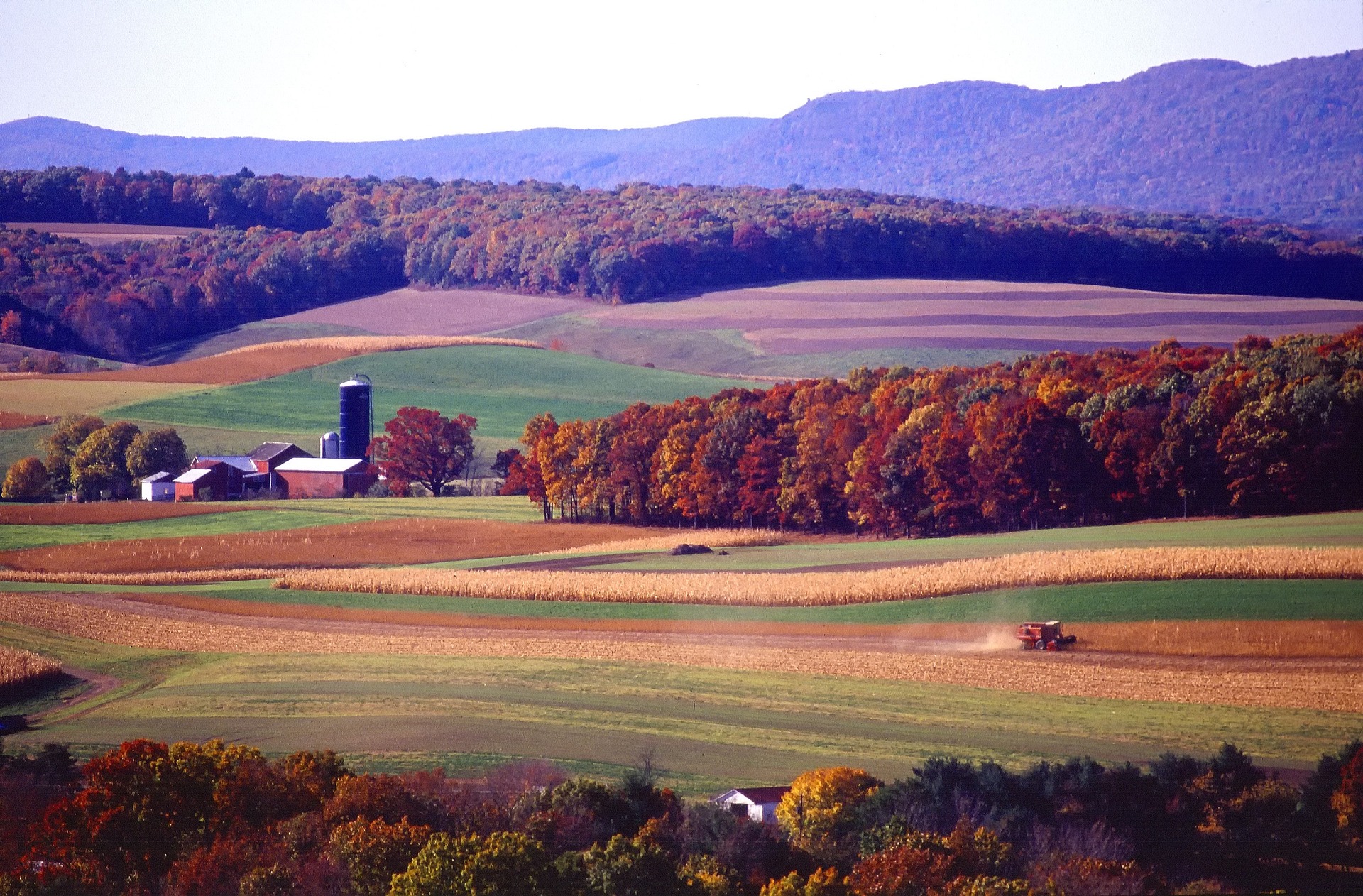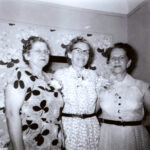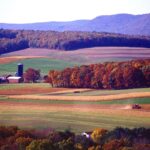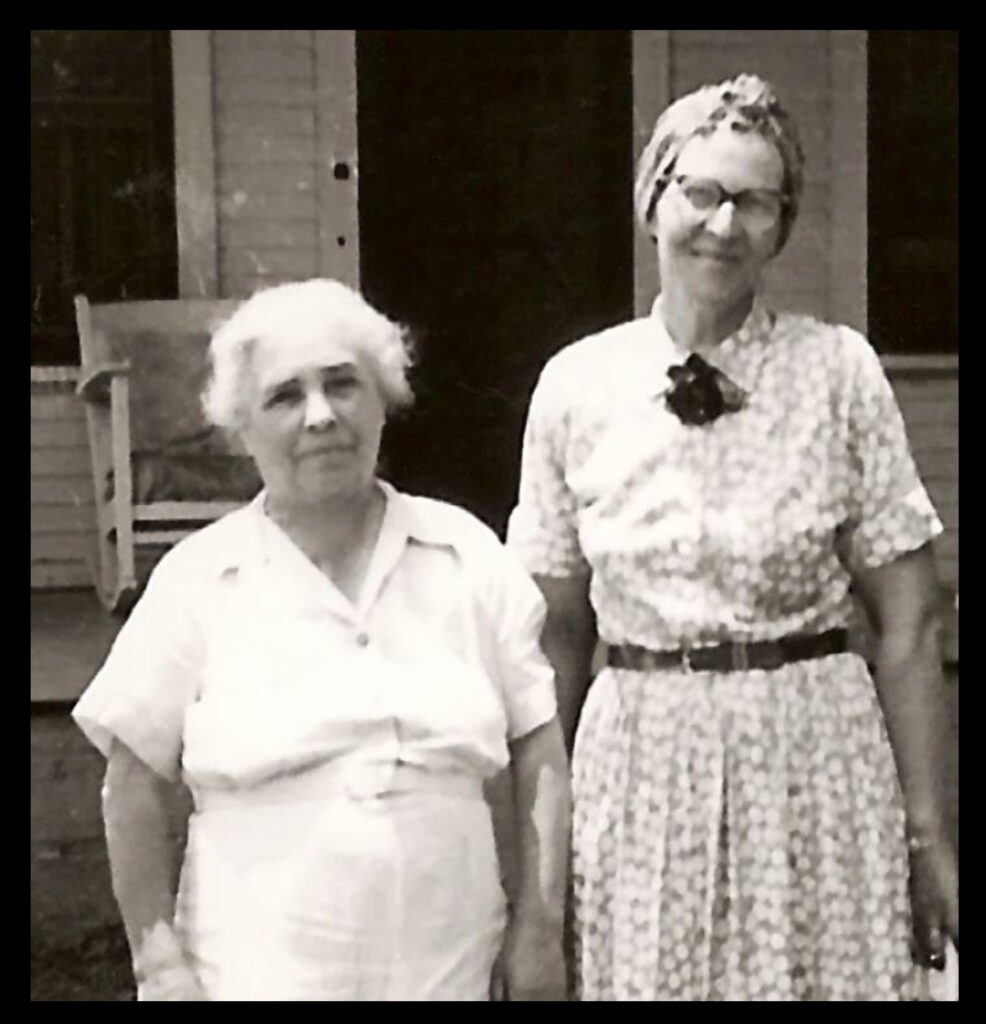In the rolling fields of Coleraine, Lancaster County, a trench winds its way through the land, a relic of a time nearly forgotten. Dug by hand nearly three centuries ago, it was Gabriel Morison’s answer to the untamed frontier, a defense against wandering cattle and a testament to the sheer determination of a man who carved out a new life in America. Though time has softened its edges and grass has crept over its banks, the trench remains, just as his legacy lingers in the land, the stories, and the descendants who still call this place home.
Gabriel Morison was a man of faith, resilience, and determination. Born in Londonderry, Northern Ireland, he left his homeland after the death of his father, John. Under the laws of primogeniture, his older brother inherited nearly everything, leaving Gabriel and his brothers to forge their own path. Rather than accept a diminished future, Gabriel chose the promise of the New World, setting sail for America in search of opportunity and independence.
Upon his arrival, Gabriel secured over 300 acres of land in Pennsylvania’s untamed frontier. Around this time, he married Martha Glenn Wilson, beginning a family that would thrive for generations. His story is one of perseverance and success – a man who carved a farm from the wilderness, built a lasting legacy, and ensured that his children and grandchildren would inherit not just land, but the strength of character that defined him. Today, his descendants are scattered across the United States, a testament to the enduring spirit of their ancestor.
Early life and family background
Driven by limited opportunities and rigid inheritance laws in their homeland, for younger sons like Gabriel Morison, primogeniture meant that the family estate belonged to the eldest, leaving the others to seek their fortunes elsewhere. Many, like him, looked to Pennsylvania, a land of promise where they could claim their own stake in the frontier.
He entered a region teeming with new arrivals – Scotch-Irish, Germans, and English alike – each seeking land, freedom, and a future. Lancaster County was a rich but demanding frontier, where survival depended on hard work, resilience, and community. Life revolved around the farm, which sustained the body, and the church, which sustained the soul. Faith and labor were deeply intertwined, shaping not just individual lives but the very character of the region itself.
Gabriel Morison was born in Londonderry, Northern Ireland, in 1715. Little is known about his childhood, but he grew up in a land shaped by religious and political tensions.
Gabriel came from a Scottish lineage, his ancestors having emigrated from Ayrshire or Lanarkshire, Scotland, likely as part of the Scottish Covenanter movement. His family was Presbyterian, and their arrival in Northern Ireland placed them in the midst of a politically charged and often volatile landscape where tensions between Catholics and Protestants ran high.
The conflict in Northern Ireland would have deeply influenced Gabriel’s worldview, instilling in him both a strong sense of faith and resilience. As a younger son, he had few prospects under the rigid inheritance system, which favored the eldest. It took courage and ambition for him to leave behind everything familiar, cross an ocean, and carve out a new life in the American colonies.
Life in Lancaster County, Pennsylvania
Long before European settlers arrived, Lancaster County was home to the Susquehannock people, a powerful and resourceful nation. They thrived along the Susquehanna River, practicing slash-and-burn agriculture, which enriched the soil for planting. The Three Sisters—corn, beans, and squash—formed the foundation of their diet, while their strategic location made them successful fur traders with early European explorers. However, by the late 1600s, disease, war, and displacement decimated their population, leaving much of their land open for settlement when waves of immigrants arrived in the early 1700s.
For these early settlers, Lancaster County was a land of opportunity—but also of immense challenge. The first European farmers, many of whom were Scotch-Irish and German, practiced subsistence farming, growing just enough food for their families and selling any surplus at local markets. The first few years were grueling—forests had to be cleared, tree roots pulled, and rocky soil cultivated before fields could be productive. The Scotch-Irish, known for their fierce independence, spread out across the countryside, focusing on wheat and livestock rather than clustered village life.
With money scarce, Lancaster’s early farmers relied heavily on bartering. Goods and services were exchanged for food, supplies, or labor—perhaps a barrel of wheat for blacksmithing or a side of beef for help with harvesting.
By the time Gabriel Morison obtained land in Lancaster County, the region had already earned its reputation as the “Breadbasket of America.” Generations of farmers had perfected techniques like crop rotation, soil conservation, and durable barn-building methods, traditions that would endure for centuries.
Beyond farming, family ties and landownership were at the heart of life in Lancaster County. Gabriel strengthened his position through marriage to a member of the Wilson family, connecting him to other prominent settlers. These relationships weren’t just social—they shaped land deals, business opportunities, and community influence. In a world where survival depended on hard work, resilience, and cooperation, such connections were as valuable as the land itself.
Morison Family Farm
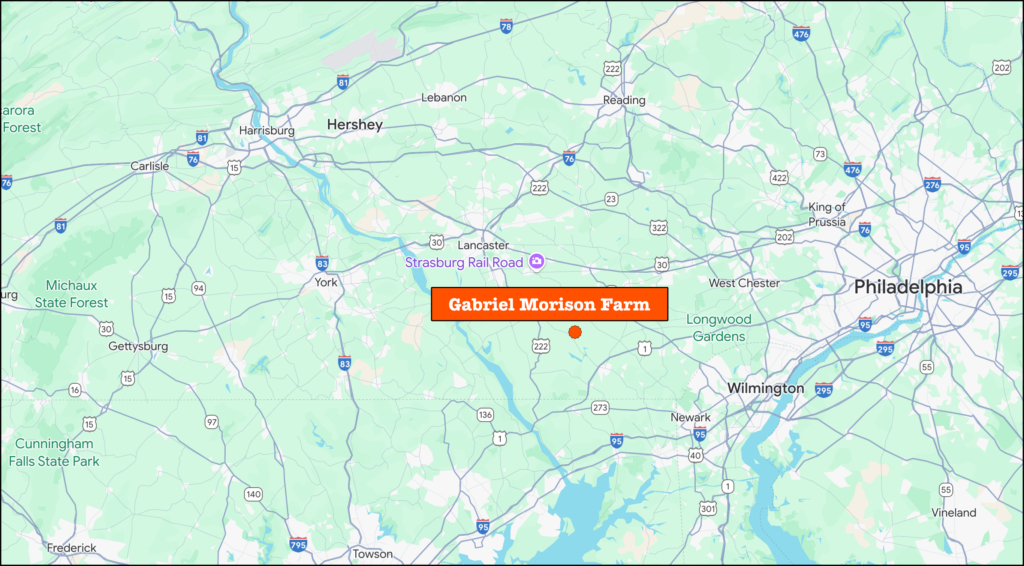
As the frontier of Pennsylvania expanded in the mid-18th century, land ownership signified both opportunity and stability for settlers. Gabriel Morison was among those who took advantage of the land distribution system in Lancaster County, securing several tracts in Colerain Township through official land warrants and surveys. His early acquisitions reflect a deliberate effort to establish a homestead and expand his holdings in a region populated by Scotch-Irish immigrants like himself.
Gabriel Morison first appears in the Early Landowners of Lancaster County, Pennsylvania records through two separate land applications, both filed in 1767:
April 7, 1767: 6 Acres, 18 Perches (East Side Application #2473)
Gabriel applied for a 6-acre, 18-perch tract adjacent to the property of Jeremiah McFadin in Colerain Township. This survey was later recorded in Survey Book A11, page 282. This relatively small parcel may have been an extension of an existing homestead or a strategic acquisition to secure water access, timber resources, or pastureland.
May 5, 1767: 16 Acres, 70 Perches (East Side Application #2570)
Just a month later, Gabriel submitted another application for a larger 16-acre, 70-perch tract, also located in Colerain Township and adjacent to his earlier claim. This survey was documented in Survey Book A11, page 284. His decision to file for another tract so soon suggests he was actively expanding his landholdings, possibly to support farming, livestock, or future family settlement.
These acquisitions were made under Pennsylvania’s East Side Applications system, a land distribution method that allowed settlers to stake claims before officially patenting their properties.
The East Side Applications System
Gabriel Morison’s land transactions were part of the East Side Applications Register, a process managed by the Pennsylvania Historical and Museum Commission (PHMC). This system enabled settlers to apply for unclaimed land, which was then surveyed and documented. Once the necessary payments and required improvements were made – such as clearing land, constructing buildings, or farming – the land could be patented, granting full legal ownership.
For Scotch-Irish settlers like Gabriel, this system provided a structured means of acquiring land in a rapidly developing region. Lancaster County, with its rolling hills, fertile farmland, and proximity to trade routes, was a prime location for settlement. The ability to secure land through applications and surveys gave settlers like Gabriel a foothold in a new world, ensuring economic security and a future for their families.
The French and Indian War (1754-1763)
During the French and Indian War , Lancaster County stood as the edge of Pennsylvania’s western frontier, a vulnerable outpost in a time of upheaval. Gabriel Morison and his family would have witnessed firsthand the growing tensions as refugees poured eastward, fleeing from the brutal attacks on settlements in western Pennsylvania. As Native American forces, allied with the French, raided homesteads and forts, frightened families – some wounded, others grieving – would have arrived in Lancaster, seeking shelter and safety.
For farmers like Gabriel, the war wasn’t just a distant conflict; it disrupted daily life and commerce. Trade routes became treacherous, cutting off the ability to sell crops and goods, making it harder for frontier communities to sustain themselves. The British government, desperate to fund the war, increased taxes, placing a heavier burden on landowners like Gabriel. While he had carved out a successful farm, the uncertainty of war and economic strain would have made these years difficult.
Despite these hardships, Gabriel remained a respected figure in his community. In 1759, he was called to serve on a jury for a criminal case, listed as the 39th person on the jury roll. Jury duty was not randomly assigned – it was a responsibility given to landowners and men of standing, those considered capable of fair judgment. His inclusion on the list suggests that Gabriel was a trusted and influential member of Lancaster County, a man whose voice carried weight in matters of justice.
The Revolutionary War
During the Revolutionary War, Gabriel would have been around 60 years old. While too old for active military service, he may have contributed in other ways, such as providing supplies, serving in a local militia in a non-combat role, or being involved in civic duties like jury service or township governance. If he owned land, he might have been affected by wartime taxes, local conflicts, or shifts in political allegiances.
According to an application for the Sons of the American Revolutionary War, Gabriel’s son, Alexander did teaming for the government during the war. This refers to hauling or transporting goods, supplies, or equipment using teams of horses or oxen and wagons. The Continental Army lacked a formal supply chain, so private citizens and contractors played a vital role in keeping the army functional. Teamsters like Alexander were critical to the war effort, ensuring that Washington’s troops had the supplies needed to continue fighting.
Gabriel passed away in 1799 in Colerain, Lancaster County, Pennsylvania, leaving behind a thriving farm and a legacy that extended far beyond his land. His many descendants went on to become doctors, military leaders, ministers, and farmers, each contributing in their own way to the growth and development of the young nation. Through their efforts, they played a role in shaping the country’s future, carrying forward the values of hard work, service, and resilience that defined Gabriel’s life.
Gabriel’s Legacy
His story is emblematic of thousands of early American settlers whose contributions – though not always recorded in history books – formed the backbone of the nation. His legacy highlights the importance of ordinary people in building America: farmers who fed communities, ministers who guided moral and civic life, soldiers who defended the nation, and professionals who helped expand knowledge and services.
Gabriel Morison’s life is a testament to the determination, resilience, and civic engagement that defined early America. His experiences – immigrating to Pennsylvania, acquiring land, serving in local governance, and raising a family that supported the Revolution – mirror the larger American journey from colonial settlement to independence and nation-building.
While history often focuses on great leaders, it was men like Gabriel – farmers, jurors, fathers, and patriots who quietly laid the foundation for what America would become.
Notes;
I have chosen to use the older spelling of “Morison” because that is how Gabriel’s name appears in the earliest records. Later in life, the spelling changed to “Morrison.”
Across the Sea: Listen to a song that captures the epic journey of Gabriel Morison and his family, from Scotland to Ireland, and finally to Pennsylvania. It blends history, resilience, and tradition into a sweeping folk rock anthem, telling their story through rich imagery and a steady, rhythmic build. (created using Suno AI)

